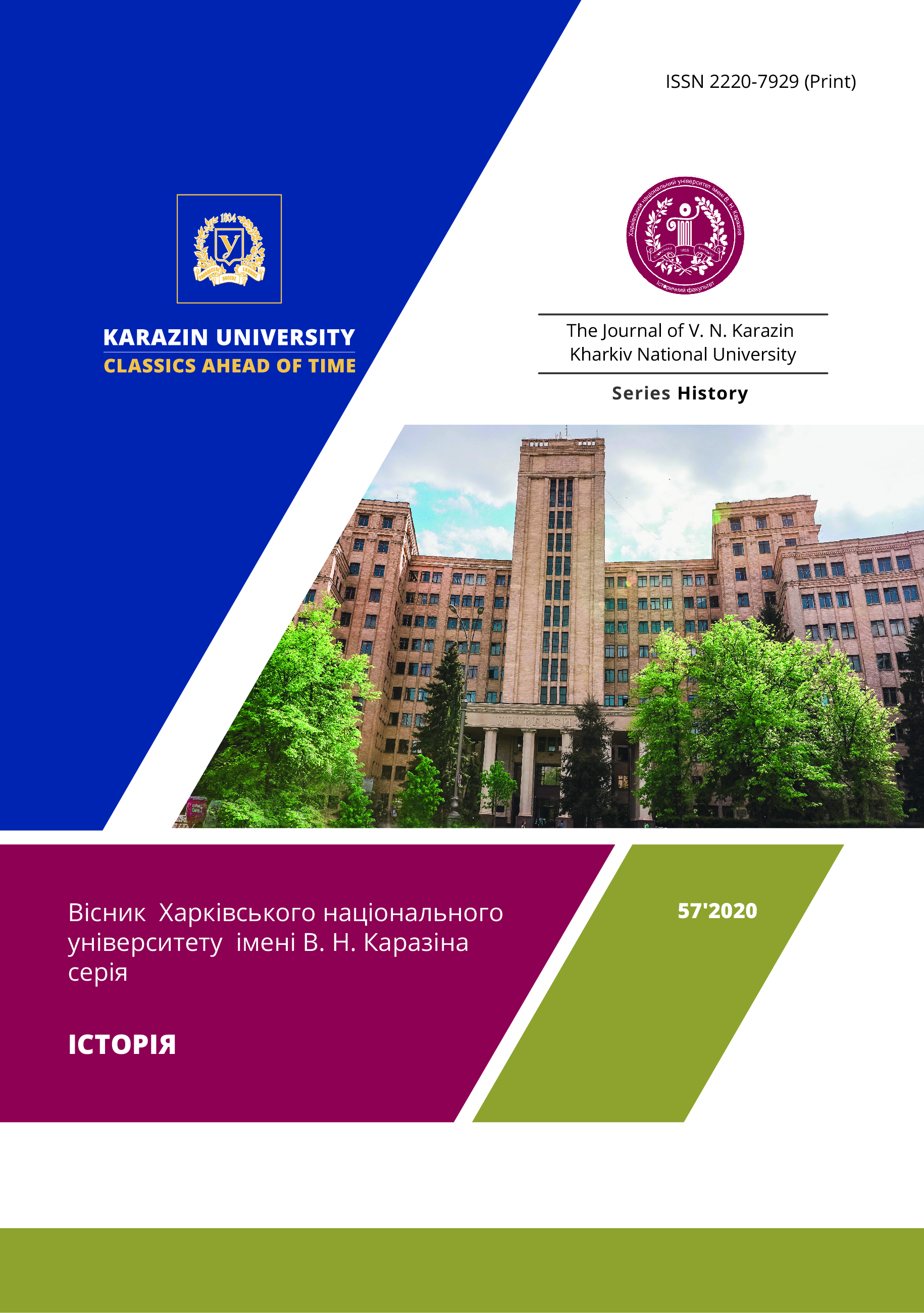The Formation of the Monumental and Memorial Space of Donetsk
Abstract
Donetsk is a city, which located in the south-eastern part of Ukraine, the beginnings of which can be traced back to the last quarter of the ХVІІІ century. During the ХХ century the city of Yuzivka – Staline – Donetsk turned into an industrial centre in within the Russian Empire and later the USSR. Accordingly, it was formed its monumental-memorial space, the analysis of which is the purpose of this research. Legislative documents and registers have been worked out for its implementation historical and cultural monuments, statistics, periodicals. The article showed that the monumental tradition of Donetsk was formed mostly in the Soviet era, most intensively in the 1950th – 1980th. The monuments concerned the significant events of that time – «the Great October Socialist Revolution», «the Civil War», «the Great Patriotic War», many objects are dedicated to work, including mining. They purposefully worked on the formation of Soviet identity of citizens. A tribute to Ukrainian history and culture has been found in the monuments T. Shevchenko, I. Frank, B. Khmelnitsky. However, their installation is small formal – except for the first, these objects were placed on the periphery of Donetsk. It is shown that in the years of independent Ukraine in the city was installed one and a half dozens of monuments dedicated to people whose lives and activities they were related to Donetsk or Donetsk region – A. Solovyanenko, J. Hughes, Holocaust victims, internationalist soldiers, militiamen dead, the mother of women, victims of political repression, victims of Chernobyl catastrophe, rescue hero and others. Сonstruction of monuments in the postsoviet decades focused on fostering pride in prominent countrymens and on this led to the formation of regional patriotism. With Soviet-era monuments have always been preserved alongside new ones memorials, what contributed to the position of the Donetsk City Council, deputies who repeatedly stated the need for the demolition of the Soviet memorials. In the course of the study it was possible to reach a conclusion mainly Soviet filling the monumental and memorial space of Donetsk, which is also on boundaries of the XX–XXI centuries did not undergo significant changes, which influenced the formation specific identity that fit into the notion of local, «Donetsk» patriotism.
Downloads
References
Денисенко, Г., Денисенко, О. Меморіальний простір України у формуванні історичної пам’яті. Україна XX століття: культура, ідеологія, політика, вип. 21, 2016, с. 187-99.
Донецькі депутати сумують за тоталітаризмом. Available at:
Федько, А. Памятник императору Александру II в Юзовке. Архивные документы. Available at:
Горсовет Донецка отказался сносить советские памятники. Available at:
Грицак, Я. Історія двох міст. Україна модерна, № 12 (2), 2007, с. 27-60.
Кармазіна, М. С. Політичні ідентичності в сучасній Україні: міська громада Донецька. Київ, 2016.
Кульчицький, С., Якубова, Л. Триста років самотності: український Донбас у пошуках смислів і Батьківщини. Київ, 2016.
Куромія, Г. Свобода і терор у Донбасі: Українсько-російське прикордоння, 1870-1990-і роки. Київ, 2002.
Кузіна, К. В., Лихолобова, З. Г. Соціально-економічні процеси у монопрофільних шахтарських містах Донбасу (1950-1980-ті роки). Донецьк, 2010.
Кузьо, Т. Война Путина против Украины. Революция, национализм и криминалитет. Киев, 2018.
Мэр Донецка отказался сносить советские памятники. Newsland. Available at:
Міхеєва, О. Державна ідеологія та конструювання спільної пам’яті про минуле: організоване забуття та феномен пригадування (на прикладі пам’ятників Донецька). У зб.: Сучасні суспільні проблеми у вимірі соціології управління. Донецьк, 2006, с. 175-84.
Міхеєва, О. К. Сучасне місто у пошуках публічного простору: на прикладі Донецька. Сучасні суспільні проблеми у вимірі соціології управління: Збірник наукових праць ДонДУУ. Серія «Спеціальні та галузеві соціології», т. 14, вип. 258, 2013, с. 560-68.
Перелік пам`яток культурної спадщини місцевого значення Донецької області, занесених до Державного реєстру нерухомих пам’яток України. Державний реєстр нерухомих пам'яток України (місцевого значення) станом на 15 березня 2016 року. Available at:
Пірко, В. О. Заселення Донеччини у XVI-XVIII ст. (короткий історичний нарис і уривки з джерел). Донецьк, 2003.
Реєстр культурного надбання Донецької області (пам’ятки історії та культури). Available at:
Родионов, А. В Донецке открыли памятник расколу Украины. Новости Донбасса. 11 сентября, 2009. Available at:
Стасюк, І. Реєстр пам’яток місцевого значення та його роль у збереженні культурної спадщини. У зб.: Історико-культурна спадщина: європейський вимір: тези Всеукраїнської науково-практичної конференції. Львів, 2018, с. 121-25.
Студенна-Скруква, М. Український Донбас: Обличчя регіональної ідентичності. Київ, 2014.
Симоненко, І. М. Меморіальний простір України: кризовий стан та шляхи оздоровлення. Стратегічні пріоритети, № 4 (13), 2009, с. 53-63.
Символіка. Донецька обласна державна адміністрація. Available at:
Указ Президента України № 250/2007 «Про заходи у зв'язку з 75-ми роковинами Голодомору 1932-1933 років в Україні». Available at:
Донецька обл. Українсько-канадський дослідчо-документаційний центр. Available at:
Copyright (c) 2020 Temirova N. R.

This work is licensed under a Creative Commons Attribution 4.0 International License.
Authors who publish with this journal agree to the following terms:
- Authors retain copyright and grant the journal right of first publication with the work simultaneously licensed under a Creative Commons Attribution License that allows others to share the work with an acknowledgement of the work's authorship and initial publication in this journal.
- Authors are able to enter into separate, additional contractual arrangements for the non-exclusive distribution of the journal's published version of the work (e.g., post it to an institutional repository or publish it in a book), with an acknowledgement of its initial publication in this journal.
- Authors are permitted and encouraged to post their work online (e.g., in institutional repositories or on their website) prior to and during the submission process, as it can lead to productive exchanges, as well as earlier and greater citation of published work (See The Effect of Open Access).




